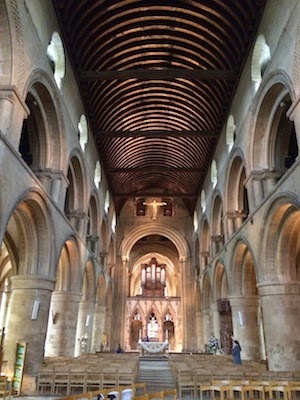| Gloucester Cathedral |
Some travel addicts combine their love of some other activity to achieve a travel double-whammy. There’s no shortage of Americans executing a plan to attend a game at every MLB park or every NFL stadium, for example. The result is often a well-defined list of to-sees or to-dos. It seems there’s something therapeutic for those of us afflicted with wanderlust to work through a multi-year list of objectives. This empty nest travel couple’s recently established goal is to visit every Church of England cathedral in England.
The goal came about after-the-fact: we had already visited a handful of them on this trip when the idea occurred to us. In our previous swing through England in August, we visited the cathedrals in Manchester, Chester, Liverpool, York, and Carlisle. Somewhere along the way we asked ourselves, “Why don’t we just go ahead and see all of them?” So while we have a passion for architecture, we aren’t Anglican (we’re Catholic), but nevertheless, that’s what we’ve set out to do: see all the Church of England cathedrals, all 42 of them. Who knows, there might one day be a coffee table book of our efforts.
Today we introduce you to four more English cathedrals, the ones we’ve visited the last three weeks we’ve been situated in Nottinghamshire in the English Midlands. Next week, while in London, we (of course) plan to visit England’s largest cathedral, Saint Paul’s.
Gloucester Cathedral
| The Cloisters of Gloucester Cathedral (Do You Recognize Them?) |
The cathedral of Gloucester (pronounced “GLOSS-ster”), or more properly the Cathedral Church of Saint Peter and the Holy and Indivisible Trinity, is a Norman-cored cathedral originating from the late 11th and early 12th centuries. It replaced a Saxon abbey from the 7th century dedicated to Saint Peter, hence the formal dedication to Saint Peter. It first became a cathedral–the home of a bishop–in the late 14th century. Subsequent additions and modifications were mostly gothic in styling.
Gloucester Cathedral’s round, Norman columns are among the most impressive you’ll ever see. The cathedral’s cloisters are not only beautiful, they were used in the filming of some of the Harry Potter movies. The cathedral is also the burial place of King Edward, II, whose grand memorial bears the graffiti of school children from the 1700’s. The day we visited, the cathedral was full of a temporary art exhibit, but one of the most sought-after sights at Gloucester Cathedral is perhaps the earliest depiction of a golfer: it can be found at the bottom of the fourth panel from the right in the Great Eastern stained glass window.
 |
| Stained Glass Golfer |
Sheffield’s Cathedral Church of Saint Peter and Saint Paul, offers a unique blend of old and new. Most of its life it’s been a lowly parish church, but in 1914 it was made a cathedral with the creation of the diocese of Sheffield. Built in the mid 1400’s, the cathedral is relatively young. However, like most English churches, it was built to replace parish churches dating much earlier. Chapels were added as the church thrived in the ensuing two centuries, and major plans were drawn up in the late 1800’s that never came to fruition. Instead, a grand modern tower was added at the west end, capped by a pyramid of wood and stained glass. You’d think the melding of old and modern would look incongruous, but it works nicely.
| Modern Tower at Sheffield Cathedral |
http://www.sheffieldcathedral.org/
Southwell Cathedral
| Southwell Cathedral |
Southwell (pronounced “SUH-thul”) Cathedral has quite a few roles. It is also known as Southwell Minster, a term usually applied to mission churches. It is also a functioning parish church for the local community in Southwell. And of course it is a cathedral, the home church of the bishop of the Diocese of Southwell and Nottingham. It is a grand and unique structure, with its signature two towers and its double-arched Norman nave.
A church has stood on this spot since the late 600’s, with construction on the current Norman building beginning in 1108 and likely incorporated parts of the original Saxon facility. Immediately next door to the cathedral are the ruins of the Archbishop of York’s residence. The cathedral was the site of King Charles I’s capture during the English Civil War, and as a result sustained considerable damage. It was also struck by lightning in 1711 and suffered a good deal of damage from the resulting fire.
 |
| Southwell Cathedral’s Double Arched Nave |
 |
| Modern Stations of the Cross, Southwell Cathedral |
http://www.southwellminster.org/
Derby Cathedral
| Derby Cathedral, The Smallest Cathedral in England |
The Cathedral of All Saints of Derby (pronounced “DAR-bee”, not “DUR-bee”) is the see of the Bishop of Derby. The original, parish, church was built by King Edmund I in the 10th century. It was replaced in the 14th century, but that building was replaced again in the 1700’s (all that remains of the 14th century structure is the tower, billed as the tallest cathedral tower in England).
The Derby Cathedral, probably owing to it’s relative youth (not quite 300 years old), is the most unique we’ve seen yet. Most cathedrals are imposing structures of stone: dim and dark though imposing and awe-inspiring. Derby’s cathedral is light and airy, with barely a smidgen of stone exposed. There are modern art stained glass windows and the altar is bathed in light. The Derby Cathedral is perhaps best known as the burial place of Bess of Hardwick (builder of Chatsworth House), but we found the memorial plaque to Florence Nightingale–another famous product of Derbyshire–a fittingly simple tribute.
 |
| Florence Nightingale Memorial |
 |
| Bess of Hardwick Memorial and Tomb |






